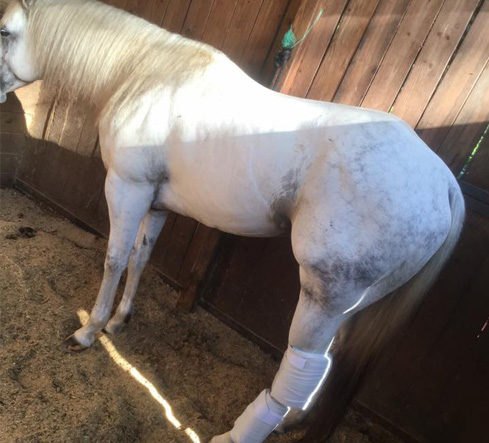Ice Boot
FlowBoot intended for cold therapy is three times the foam in comparison to the performance boot. It is an easy, safe, and effective way of providing cold compression. The open cell foam will absorb water, which can be frozen or submersed in ice water. Cold compression is significantly colder than ice alone due to improved skin contact and increased tissue density. Tissue reaches its lowest temperature faster and the tissue maintains it is cool even after treatment ends. One size fits all. Wraps are 6 inches wide making it easy to apply. Twenty minutes of even pressure without cutting off the blood flow to the foot, ideal therapy post strenuous work. Flowboot targets the superficial digital flexor tendon and proximal sesamoid area, which is where most problems occur. Keeping the heat and swelling out promotes recovery and prevents soreness.
- Soak boots in water over night, then place individually in a plastic bag.
- Stuff the top of the bag inside the middle portion of the boots to keep sides from touching and place in freezer until frozen. (The plastic keeps the boots from sticking to each other and to the freezer.)
- When ready to use, thaw the boot slightly in water or add a little water to plastic.
- Once pliable, strap on boots with the wrap.
- Leave the boots on 20 to 30 minutes. (20 minutes is what the medical feld recommends, but if there is an injury or hot spot, reapply multiple times.)
- If on the road, keep the boots in ice water. *It’s best to use when the horses body is already cooled off. Rubbing alcohol can be used to disinfect and will help the cold. Water is the conducting element and transfers the cold, best when wet.
The Cold Compression Hock and Knee boot has 30 ice blankets embedded inside a pillow of soft foam. Combined with a wrap, the foam is compressed making cold therapy easy and effective. No pumps, hoses, wires, or need to readjust. We all know cryotherapy is the best, but it is expensive and time consuming. Not anymore! Freeze the boot, wrap it, providing a soft, even, and penetrating cold. Imagine a memory foam pillow with ice inside – soft yet cold. Horses love it, no hard ice on the skin, or unevenness of cold. Frozen the boot will stay cold well past the recommended time of 15 to 20 minutes.
With compression, the cold transfers deeply taking out the heat preventing soreness and inflammation. This unique design makes this boot versatile and can be used on knees or hocks. One size fits all. Sold in pairs – two boots and two wraps. This product makes all the other boots and gadgets obsolete. Try it for yourself and if you don’t agree, send it back for a full refund. This patent pending concept is a must have for instant treatment.
- Decreased muscle spasms
- Decreased tissue damage
- Decreased swelling
When a horse sustains an injury, there is always a risk for inflammation and tissue damage. Research shows that cold compression therapy can shorten recovery time by as much as 50%.
Use cold compression therapy when your horse experiences:
- Sore tendons and muscles surrounding joints
- Sore feet
- Inflammation around the feet
For more information about when to use cold compression therapy, consult your equine veterinarian.
- Soak boots in water over night, then place individually in a plastic bag.
- Stuff the top of the bag inside the middle portion of the boots to keep sides from touching and place in freezer until frozen. (The plastic keeps the boots from sticking to each other and to the freezer.)
- When ready to use, thaw the boot slightly in water or add a little water to plastic.
- Once pliable, strap on boots with the wrap.
- Leave the boots on 20 to 30 minutes. (20 minutes is what the medical feld recommends, but if there is an injury or hot spot, reapply multiple times.)
- If on the road, keep the boots in ice water. *It’s best to use when the horses body is already cooled off. Rubbing alcohol can be used to disinfect and will help the cold. Water is the conducting element and transfers the cold, best when wet.

